2B_Unit1
2年级朗文小学英语2B unit1 第一课
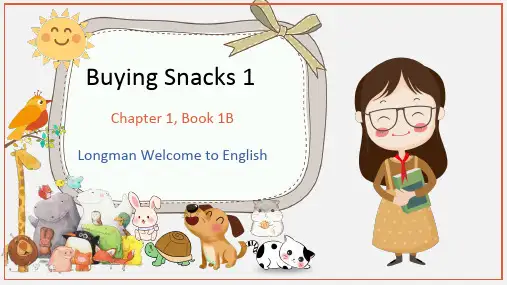
What does he like? He likes__f_is_h_ .
What does she like?
She likes __p_ot_a_to_c_h_ip_s .
What does Chocolate like?
Chocolate likes _r_a_isi_ns_.
What does Johnny like?
Buying Snacks 1
Chapter 1, Book 1B Longman Welcome to English
学习目标
1.能够识别不同零食的名称: sour plum, lemon sweets, sweets, chilli fish, potato chips, raisins…
2.学会问和回答喜欢吃什么零食 What does… like? He/She ikes…
看图填空
I he she like likes
1. __I ___ ____li_k_e__ chilli fish.
2.__S_h_e_ ___li_k_e_s potato chips 3. __H_e__ __l_ik_e_s__lemon sweets.
see you!
Johnny likes lemon sweets and sour plums.
What does Sally like?
She likes __c_h_illi_f_ish_.
What does Spencer like?
He likes potato chips and sour plums.
A He likes raisins. B She likes raisins.
( )3. Tom and Sally lemon sweets.
英语九年级全一册unit1 2b知识点
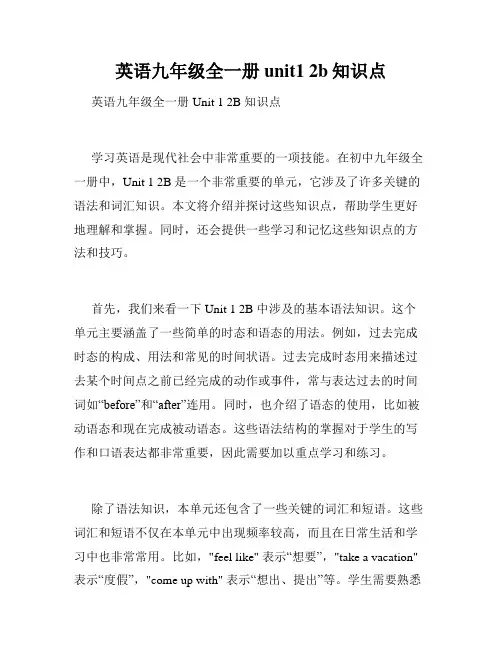
英语九年级全一册unit1 2b知识点英语九年级全一册Unit 1 2B 知识点学习英语是现代社会中非常重要的一项技能。
在初中九年级全一册中,Unit 1 2B 是一个非常重要的单元,它涉及了许多关键的语法和词汇知识。
本文将介绍并探讨这些知识点,帮助学生更好地理解和掌握。
同时,还会提供一些学习和记忆这些知识点的方法和技巧。
首先,我们来看一下Unit 1 2B 中涉及的基本语法知识。
这个单元主要涵盖了一些简单的时态和语态的用法。
例如,过去完成时态的构成、用法和常见的时间状语。
过去完成时态用来描述过去某个时间点之前已经完成的动作或事件,常与表达过去的时间词如“before”和“after”连用。
同时,也介绍了语态的使用,比如被动语态和现在完成被动语态。
这些语法结构的掌握对于学生的写作和口语表达都非常重要,因此需要加以重点学习和练习。
除了语法知识,本单元还包含了一些关键的词汇和短语。
这些词汇和短语不仅在本单元中出现频率较高,而且在日常生活和学习中也非常常用。
比如,"feel like" 表示“想要”,"take a vacation" 表示“度假”,"come up with" 表示“想出、提出”等。
学生需要熟悉这些词汇和短语的用法,才能更好地理解和运用它们。
在学习这些词汇和短语时,可以结合实际情境进行练习,例如通过口语对话、写作等方式来巩固记忆。
此外,Unit 1 2B 还涉及了一些重要的语言技能和学习策略。
在这个单元中,学生需要学会阅读理解并提取关键信息,同时也需要学会撰写文章和故事。
为了更好地理解和掌握这些技能,学生可以通过阅读英文文章、做练习题、参加角色扮演等方式来提高自己的阅读和写作能力。
对于学生而言,通过多种途径进行复习和巩固是非常关键的。
可以结合课本、教师提供的相关资料以及网络上的学习资源,进行系统的学习和练习。
同时,也可以组织学习小组或找到学习伙伴一起共同学习和讨论,相互督促、分享经验,提高学习效果。
unit(1-8)知识点 小学二年级下册英语译林版2b下载打印
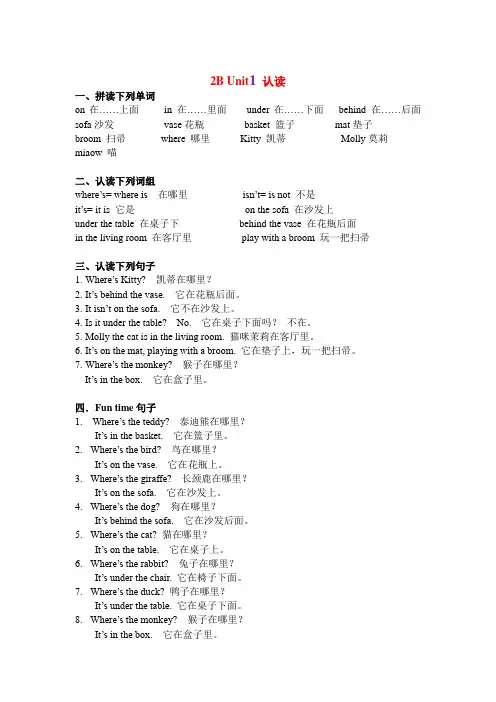
2B Unit1认读一、拼读下列单词on在……上面in 在……里面under在……下面behind 在……后面sofa沙发vase花瓶basket 篮子mat垫子broom 扫帚where 哪里Kitty 凯蒂Molly莫莉miaow 喵二、认读下列词组where’s= where is 在哪里isn’t= is not 不是it’s= it is 它是on the sofa 在沙发上under the table 在桌子下behind the vase 在花瓶后面in the living room 在客厅里play with a broom 玩一把扫帚三、认读下列句子1.Where’s Kitty? 凯蒂在哪里?2.It’s behind the vase. 它在花瓶后面。
3.It isn’t on the sofa. 它不在沙发上。
4.Is it under the table? No. 它在桌子下面吗?不在。
5.Molly the cat is in the living room. 猫咪茉莉在客厅里。
6.It’s on the mat, playing with a broom. 它在垫子上,玩一把扫帚。
7.Where’s the monkey? 猴子在哪里?It’s in the box. 它在盒子里。
四.Fun time句子1. Where’s the teddy? 泰迪熊在哪里?It’s in the basket. 它在篮子里。
2.Where’s the bird? 鸟在哪里?It’s on the vase. 它在花瓶上。
3.Where’s the giraffe? 长颈鹿在哪里?It’s on the sofa. 它在沙发上。
4.Where’s the dog? 狗在哪里?It’s behind the sofa. 它在沙发后面。
5.Where’s the cat? 猫在哪里?It’s on the table. 它在桌子上。
人教版英语八年级上册Unit12b
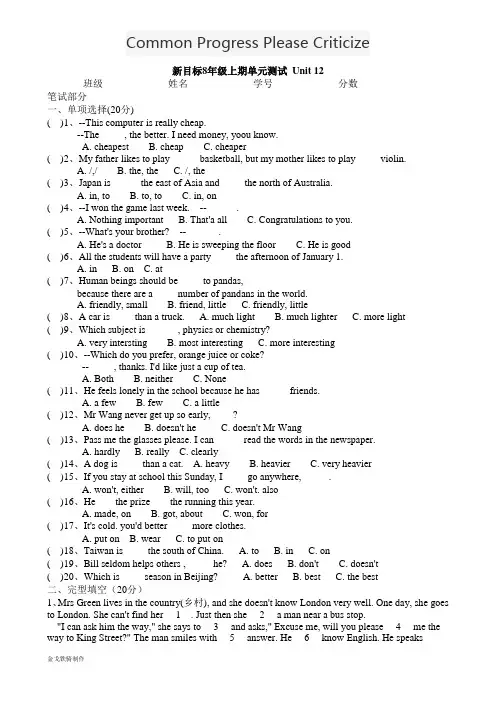
新目标8年级上期单元测试Unit 12班级___________ 姓名___________ 学号___________ 分数___________笔试部分一、单项选择(20分)( )1、--This computer is really cheap.--The_____, the better. I need money, yoou know.A. cheapestB. cheapC. cheaper( )2、My father likes to play _____ basketball, but my mother likes to play ____ violin.A. /,/B. the, theC. /, the( )3、Japan is _____ the east of Asia and ____ the north of Australia.A. in, toB. to, toC. in, on( )4、--I won the game last week. --______.A. Nothing importantB. That'a allC. Congratulations to you.( )5、--What's your brother? -- ______.A. He's a doctorB. He is sweeping the floorC. He is good( )6、All the students will have a party ____ the afternoon of January 1.A. inB. onC. at( )7、Human beings should be ____ to pandas,because there are a ____ number of pandans in the world.A. friendly, smallB. friend, littleC. friendly, little( )8、A car is ____ than a truck. A. much light B. much lighter C. more light( )9、Which subject is ______, physics or chemistry?A. very interstingB. most interestingC. more interesting( )10、--Which do you prefer, orange juice or coke?--_____, thanks. I'd like just a cup of tea.A. BothB. neitherC. None( )11、He feels lonely in the school because he has _____ friends.A. a fewB. fewC. a little( )12、Mr Wang never get up so early, ____?A. does heB. doesn't heC. doesn't Mr Wang( )13、Pass me the glasses please. I can _____ read the words in the newspaper.A. hardlyB. reallyC. clearly( )14、A dog is ____ than a cat. A. heavy B. heavier C. very heavier( )15、If you stay at school this Sunday, I ____ go anywhere, _____.A. won't, eitherB. will, tooC. won't. also( )16、He ___ the prize ___ the running this year.A. made, onB. got, aboutC. won, for( )17、It's cold. you'd better ____ more clothes.A. put onB. wearC. to put on( )18、Taiwan is ____ the south of China. A. to B. in C. on( )19、Bill seldom helps others ,_____ he? A. does B. don't C. doesn't( )20、Which is ____ season in Beijing? A. better B. best C. the best二、完型填空(20分)1、Mrs Green lives in the country(乡村), and she doesn't know London very well. One day, she goes to London. She can't find her __1__. Just then she __2__ a man near a bus stop."I can ask him the way," she says to __3__ and asks," Excuse me, will you please __4__ me the way to King Street?" The man smiles with __5__ answer. He __6__ know English. He speaksRussian. He is a visitor. Then he __7__ his hand into his pocket(口袋), __8__ a piece of paper and lets her __9__ it. On the paper are these words, "Sorry, I __10__ English.( )1. A. street B. way C. room( )2. A. looks B. watches C. sees( )3. A. herself B. himself C. itself( )4. A. tell B. talk C. say( )5. A. not B. an C. no( )6. A. don't B. doesn't C. isn't( )7. A. puts B. takes C. carries( )8. A. bring out B. take out C. takes out( )9. A. to see B. look out C. to look out( )10.A. am not speak B. don't speak C. don't say三、阅读理解(10分)1、Bob comes out of the station and at once he doesn't know where to go. This is the first time he comes to this town. He comes to see his good friend, Peter.Peter is a worker. He works in a factory. But Bob doesn't know where the factory is.He walks in the street. He passes a hostital, a post office, a bookshop and at last he gets to a school. Some students are coming out. So he asks one of them, " Excuse me. Do you know where the Red Star Factory is?"Of course, I know. I live near there. My father works in that factory.It's outside this town." answers the boy." Is it far from here? Can you show me the way, please?" Bob asks again." I'm going home now. Will you go with me? I'll take you there."" That's great! Thank you very much!"" Then, let's go to that bus stop. We'll take No.1 bus there."( )1. Who come to this town to see his friend.A. BobB. PeterC. The boy( )2. Who does Bob ask the way?A. BobB. PeterC. A boy( )3. Where is the factory?A. Near the school.B. Outside the town.C. Near the factory.( )4. Where does the boy live?A. Near the bookshopB. Near the postofficeC. Near the factory( )5. Where do the boy and Bob go then?A. The bookshopB. The post officeC. The bus stop四、句型转换(10分)1、"Don't play on the road." the policeman said to the children.(同义)The policeman told the children ____ ____ play on the road.2、She is tall and thin. She has long hair.(合并)She is ____ tall and thin girl ____ long hair.3、Jim sometimes comes to visit us.(同义)Jim comes to visit us ____ _____.4、They needed to work out the problem with the computer.(提问)____ ____ they ____ to work out the problem with?5、The machine helps them to wash clothes.(疑问)____ the machine ____ them to wash clothes.6、I had four eggs for breakfast this morning.____ ___ eggs ___ you ____ for breakfast this morning?7、He knows a little about Chinese.(提问)____ _____ does he know about Chinese?8、A. I usually take the bus to school(同义)B. I usually _______ to school _______ bus.9、I'm free on wednesday evening.(同义)I ____ _____ on wednesday evening.10、Mary likes going shopping with her sister.(提问)____ ____ Mary like going shopping____?五、时态填空(10分)1、We ____ (make)a survey of the school in Beijing, and I found something new.2、Car is more and more popular, you'd better _____(learn) to drive.3、Jordan ________ (be) born in 1975.4、Tiger Woods started golfing when he _______ (be) ten months old.5、It's important ________ (stay) healthy for everyone.6、He is going to be an engineer when he _____(grow) up.7、It is the third time for Zidane ______ ( win) "World Player of the Year 2003" award.8、Toby ___ (win) a prize last term.9、I think you can ask him _____(help) you.10、Keep quiet, please. They ____ (have) a meeting.六、写作。
八年级上册英语书unit12b知识点
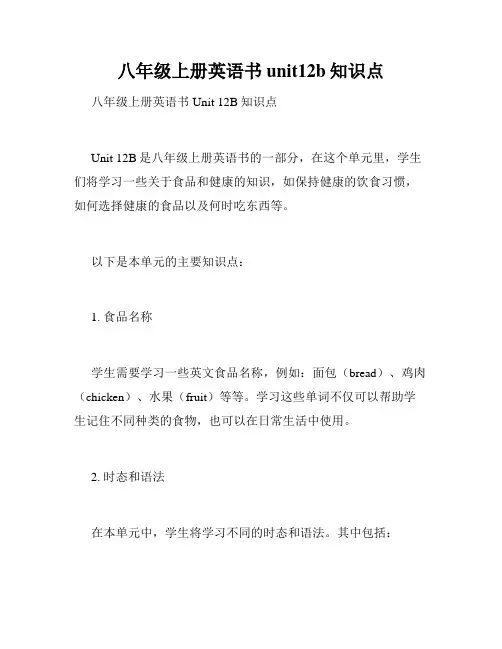
八年级上册英语书unit12b知识点八年级上册英语书Unit 12B知识点Unit 12B是八年级上册英语书的一部分,在这个单元里,学生们将学习一些关于食品和健康的知识,如保持健康的饮食习惯,如何选择健康的食品以及何时吃东西等。
以下是本单元的主要知识点:1. 食品名称学生需要学习一些英文食品名称,例如:面包(bread)、鸡肉(chicken)、水果(fruit)等等。
学习这些单词不仅可以帮助学生记住不同种类的食物,也可以在日常生活中使用。
2. 时态和语法在本单元中,学生将学习不同的时态和语法。
其中包括:(1)现在进行时(Present Continuous Tense):这个时态是用来描述目前正在发生的动作或正在进行的行为。
例如:I am eating breakfast.(我正在吃早餐。
)(2)情态动词(Modal verbs):情态动词包括can, could, may, might, should等等。
它们用来表达能力、可能性和建议等情感。
例如:You should eat more vegetables.(你应该多吃蔬菜。
)(3)主语与谓语一致:这个概念是学生必须掌握的语法知识。
当主语是单数的时候,谓语动词也必须是单数形式。
例如:Thegirl eats an apple.(那个女孩吃一个苹果。
)3. 健康习惯在本单元中,学生将学习一些关于如何保持身体健康的知识。
这些知识包括:(1)健康的饮食习惯:学生需要知道如何选择健康的食物并保持平衡的饮食。
(2)定时吃饭:学生需要知道定时吃饭的好处,以及如何合理安排自己的饮食时间。
(3)避免暴饮暴食:学生需要知道暴饮暴食的危害,以及如何避免这种情况。
4. 健康的生活方式除了正确的饮食习惯以外,学生还需要学习其他一些有益健康的生活方式。
这些方法包括:(1)参加运动:学生需要知道运动的好处,并合理安排自己的运动时间。
(2)睡眠质量:学生需要知道好的睡眠质量对身体的重要性。
初三年级Unit1 2b的译文
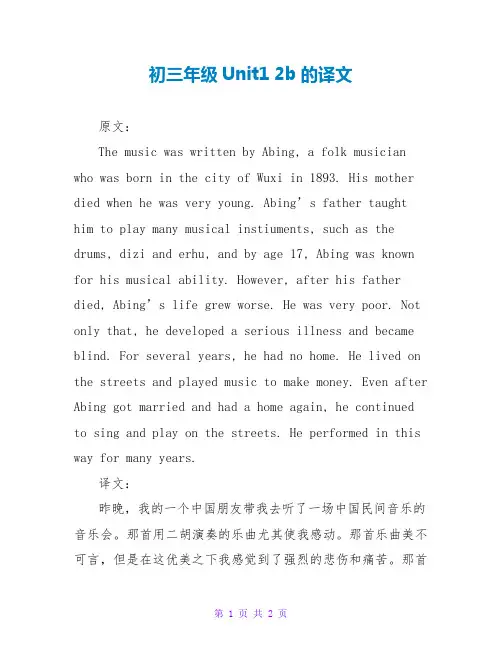
初三年级Unit1 2b的译文原文:The music was written by Abing, a folk musician who was born in the city of Wuxi in 1893. His mother died when he was very young. Abing’s father taught him to play many musical instiuments, such as the drums, dizi and erhu, and by age 17, Abing was known for his musical ability. However, after his father died, Abing’s life grew worse. He was very poor. Not only that, he developed a serious illness and became blind. For several years, he had no home. He lived on the streets and played music to make money. Even after Abing got married and had a home again, he continued to sing and play on the streets. He performed in this way for many years.译文:昨晚,我的一个中国朋友带我去听了一场中国民间音乐的音乐会。
那首用二胡演奏的乐曲尤其使我感动。
那首乐曲美不可言,但是在这优美之下我感觉到了强烈的悲伤和痛苦。
那首乐曲有一个简单的名字《二泉映月》,但它却是我听过的最感人的乐曲之一。
我后来查了《二泉映月》的历史,我开场理解音乐中的悲伤了。
这首乐曲是阿炳写的,他是一位1893年出生在无锡城的的民间音乐家。
人教版初一下英语Unit12B课文回顾重点分析及测试题解析
Unit 12 What did you do lastweekend?class_2课文精彩回顾1. (P71, 2b) My sister finished high school two weeks ago.我姐姐两个星期前高中毕业了。
【点拨】two weeks ago 意为“两星期前”,一段时间+ ago意为“多长时间之前”,是表达过去的时间状语,常与一般过去时态连用。
如:We visited the Natural History Museum three days ago.三天前,我们参观了自然历史博物馆。
拓展:before 意为“在……之前”,其后可以跟一个时间点;表示“在某个时间点之前”,但不一定用于一般过去时态。
如:I usually go to school before seven. 我常在七点钟前去上学。
此外,before也可以单独用,意为“以前”,可用于一般过去时态中。
如:I didn’t know that before.以前我不知道那件事情。
2. (P71, 2b) There we put up our tents and made a fire to keep us warm and cook food on. 在那里我们架起帐篷,生火取暖并做饭。
【点拨】本句固定短语很多:1)put up 意为“搭起;举起”,是“动词+副词”结构,当代词作宾语时,必须放在中间。
如:We need a tent. Let’s put it up. 我们需要一个帐篷,咱们把它搭起来吧。
If you have any questions, please put up your hands.如果你有什么问题,请举起手来。
2)make a fire意为“生火”,其中fire是不可数名词,但如果是“炉火,篝火,一堆火”,特指一场火灾等,前面要加不定冠词a。
如:Many people died in a fire last year. 许多人死于去年的一场火灾。
2B Unit 1 Farm animals 5
听说后进行认读,并表演故事。
扩展学生的知识。
创新能力的培养。
Ⅳ. Informal essay after teaching
T: Look at the pictures or words. Read them as quick as possible.
⒉Ask various students to point to each picture and say ‘I see a…
T: What do you see? Please point and say ‘I see a…’
A horse goes ‘Nay, nay’.
⒉Invite some students to act out their new story.
:
闪烁卡片,以慢到快,加快节奏,增加趣味性。
说话练习。
模仿动物叫声和动作,增加趣味性。
用玩具动物引出新课。
引出本课将要学的有关动物。
介绍本课教学内容,训练学生听力理解力。
T: Now let me invite some to act in front of the class. Who’ll try?
Ⅲ. Post-task activities
⒈Divide the class into pairs and encourage them to compose another verse by substituting the farm animals in the story with any other animals that they know the sounds of (e.g.) dog, cat, sheep.
Ⅰ. Pre-task preparation
朗文2B笔记unit1
unit 1 Buying snacks买零食
sour pቤተ መጻሕፍቲ ባይዱums
酸梅
柠檬糖
lemon sweets sweets 糖果
raisins 葡萄干 chocolate 巧克力 Potato chips
薯片
酪圈
peanuts 花生 cheese rings 奶
UNIT2 Sugar糖 flour 面粉 flower 花 butter 黄油
Phonics for kids 6
Unit 3 椅子上有个孩子 他的下巴上有巧克力 有一只小鸡叼着一个樱桃 小鸡正在追赶他
Picture 2 可以,给你,Cherry.不能吃太多。 Picture 3 给你,Charlie,不要吃太多。只能一天吃两颗。 Picture 4 我爱柠檬糖。 爸爸也喜欢柠檬糖。
Picture 5 现在是Charlie的睡觉时间。 睡觉时间不许吃糖果, Charlie,它们对你 的牙齿不好。 Picture6 我能吃一些柠檬糖吗? Picture7 是的,你能。现在还不是你的睡觉时间。
ginger
姜
Chilli fish 辣鱼 Curry beef balls 咖喱牛肉丸
2B Unit1 阅读部分
Picture1 Charlie ,Cherry和他们的妈妈在超 市里。孩子们想要一些零食,Charlie喜欢柠 檬糖,但是Cherry不喜欢吃。她认为它们很
酸。
妈妈,我可以买一些柠檬糖吗? 妈妈,我能买一些巧克力吗?它是甜的。
likes
Jimmy Tommy Stella Wendy Lemon sweets… Chocolate …
人教版 英语 九全一册 Unit1 2b
九年级Unit1 2bHow Can You Become a Successful Learner?Everyone is born with the ability to learn. But whether or not you can do this well depends on your learning habits. Research shows that successful learners have some good habits in common.Creating an interest in what they learnStudies show that if you are interested in something, your brain is more active and it is also easier for you to pay attention to it for a long time. Good learners often connect what they need to learn with something interesting. For example, if they need to learn English and they like music or sports, they can listen to English songs or watch sports programs in English. This way they will not get bored.Practicing and learning from mistakesGood learners think about what they are good at and what they need to practice more. Remember, “Use it or lose it”! Even if you learn something well, you will forget it unless you use it. “Practice makes perfect”. Good learners will keep practicing what they have learned, and they are not afraid of to make mistakes. Alexander Graham Bell didn’t invent the telephone overnight. He succeeded by trying many times and learning from his mistakes.Developing their study skillsIt is not enough to just study hard. Good learners know the best way they can study. For example, they may take notes by writing down key words or by drawing mind maps. They also look for ways to review what they have learned. They may do this by reading their notes every day or by explaining the information to another student.Asking questionsGood learners often ask questions during or after class. They even ask each other and try to find out the answers. Knowledge come from questioning.Learning is a lifelong journey because every day brings something new. Everything that you learn becomes a part of you and changes you, so learn wisely and learn well.一、阅读A读下面的文章,然后回到文章后的问题。
- 1、下载文档前请自行甄别文档内容的完整性,平台不提供额外的编辑、内容补充、找答案等附加服务。
- 2、"仅部分预览"的文档,不可在线预览部分如存在完整性等问题,可反馈申请退款(可完整预览的文档不适用该条件!)。
- 3、如文档侵犯您的权益,请联系客服反馈,我们会尽快为您处理(人工客服工作时间:9:00-18:30)。
课题:2B Unit1 Where’s Kitty?Story time授课时间(Period 1)教学设计:二次备课一、教学目标Learning objectives:1. Read and know the new words: on, under,behind, in, sofa, vase, basket, where.2. Read and know the new sentence pattern:Where’s…? It’s in/ on/under/ behind the…Is it…?二、教学重难点:重点:Important points:1. Read and know the new words: on, under,behind, in, sofa, vase, basket, where.2. Read and know the new sentence pattern:Where’s…? It’s in/ on/under/ behind the…Is it…?难点:Difficulties:Read and know the new sentence pattern:Where’s…? It’s in/ on/under/ behind the…Is it…?三、教学时间: 1 课时四、学情分析:Analysis of the students:Students may have difficulties in pronunciations ofthe new words; I should concern about their needsand pay more attention to them.五、教学准备:Preparations: PPT cards六、教学方法: Teaching methods:Interesting stimulating methodTask-based teaching method七、教学过程:Teaching procedures:Step 1. Warming up1.Greetings.T:Good morning, boys and girls.Ss:Good morning, Miss Lu.T: Let’s sing a song: On in underStep 2. Presentation(1)1.Show a picture of on/ in/ under/ behind.T: Do you like the song “on in under”?How many prepositions can you hear?2.Look and say:①Look, What’s this?Ss: It’s a cat.T: Where’s the cat?Teach: where(Use different ways to drill)T: It’s on the box.Teach: on(Use different ways to drill)②Now, look and guess, Where’s the cat?Ss: It’s in the box.Teach: in(Use different ways to drill)③Pair work: A: Where’s the cat?B: It’s in/ on the box.④Teach: under=un+der behind=be+hi+nd(Use different ways to drill)⑤T: The cat is playing hide and seek with you. Can you guess where is it now?Teach: sofa=so+fa vase=va+sebasket=ba+sk+et (Use different ways to drill) Step3. Presentation(2)Story time1.Watch and answer: Where’s the cat?2.Read and answer:①Is the cat on the sofa?②Is it under the table?③Is it behind the vase?Teach: Is it on/ in/ under/ behind the…?It isn’t on/ in/ under/ behind the…(Use different ways to drill)3. Listen and imitateRead together/ in groups/ in pairs.4.Act it outStep4. Consolidation1. Magic eyesTo review the new words and sentences.2. Introduce your pet’s prepositions.Look, this is my pet Kitty. It’s a cat.It’s on/ in/ under/ behind the…3. Let’s talk.八、作业设计:Homework:1. Read Story time after the tape2. Copy and recite the new words九、板书设计Unit 1 Where’s Kitty?Where’s…?It’s on/ in/ under/ behind the …教学评价:课题:2B Unit1 Where’s Kitty?Fun time授课时间(Period 2)教学设计:二次备课一、教学目标Learning objectives:1. Understand and use the key words: on, under,behind, in, sofa, vase, basket, where.2. Understand and use the sentence pattern:Where’s…? It’s in/ on/under/ behind the…Is it…?3. Apply the sentence patterns to similar situations.二、教学重难点:重点:Important points:Ss can understand and use the key words: on,under, behind, in, sofa, vase, basket, where.Ss can understand and use the sentence pattern:Where’s…? It’s in/ on/under/ behind the…Is it…?难点:Difficulties:Ss can apply the sentence patterns to similarsituations.三、教学时间: 1 课时四、学情分析:Analysis of the students:Some students may have difficulties in sentencepatterns, the teacher need to focus on the keypoints and create more real situations for studentsto practice.五、教学准备:Preparations: PPT, cards六、教学方法: Teaching methods:Situational teaching methodTask-based teaching method七、教学过程:Teaching procedures:Step1 Warming up:T: Class begins.Ss: Stand up.T: Good morning, boys and girls.Ss: Good morning, Miss Lu.T: Sit down, please.Enjoy the song: on in underStep2 Revision:1. Magic eyes(on, under, behind, in, sofa, vase, basket, where.Where’s…? It’s in/ on/under/ behind the…Is it…?)2. Let’s chantWhere, where, where’s the cat?On, on, it’s on the box.Where, where, where’s the cat?In, in, it’s on the box.Sample:Where, where, where’s the ?, , it’s the .Give more words to practice: behind, under, sofa, vase, basket, dog, monkey, rabbit, hamster, door, window, desk, table…3. Let’s match4. I can spellStep3. Fun timeShow the picture of Fun Time, and guide Ss to practice: A: Where’s the…?B: It’s…八、作业设计:Homework:1.Recite story time2.Recite the new words and get ready for a dictation九、板书设计Unit 1 Where’s Kitty?Where, where, where’s the ?, , it’s the . (behind, under, sofa, vase, basket, dog, monkey, rabbit, hamster, door, window, desk, table…)教学评价:课题:2B Unit1 Where’s Kitty?Rhyme time授课时间(Period 3)教学设计:二次备课一、教学目标Learning objectives:1、Strengthen the new words and sentence patternof this unit.2、Chant and perform the rhyme: Molly the cat3、Learn the new words: Molly, living room,broom, play with重点:Important points:1、Strengthen the new words and sentence patternof this unit.2、Chant and perform the rhyme: Molly the cat3、Learn the new words: Molly, living room,broom, play with难点:Difficulties:1、Strengthen the new words and sentence patternof this unit.三、教学时间: 1 课时四、学情分析:Analysis of the students:Some students may have difficulties in keysentence patterns, the teacher need to focus onspecial students.五、教学准备:Preparations: PPT, cards六、教学方法: Teaching methods:Situational teaching methodTask-based teaching method七、教学过程:Teaching procedures:Step 1. Warming upT: Good morning, boys and girls.Ss: Good morning, Miss Lu.T: Let’s enjoy the song: on in underStep 2 Revision1. Quick respond:(on, under, behind, in, sofa, vase, basket, where.Where’s…? It’s in/ on/under/ behind the…Is it…?)2.Guessing game:Please ask and answer in pairs.Each picture you will have ten seconds to practice.The pair who ask and answer questions correctlycan win the points for their group.(show some pictures of different prepositions )3. Let’s dubWatch the Cartoon.Students in a group to dub the story.5. Role-playInvite 3 students to act the story.Step 3 Presentation1. Show the picture of Rhyme time2. Watch and answer: What’s the cat’s name?2. Teach: Molly, living room, broom, play with(Use different ways to drill)3. Chant the rhyme together4. Chant the rhyme in group/ pairs3. Change the lyrics of the rhyme八、作业设计:Homework:1. Finish the exercises on the exercise book.2. Read and recite the new words of this chant.九、板书设计Unit 1 Where’s Kitty?Molly, living room, broom, play with 教学评价:课题:2B Unit1 Where’s Kitty?Review授课时间(Period 4)教学设计:二次备课一、教学目标Learning objectives:1、Strengthen the new words and sentence patternof this unit.2、Develop the ability of speaking and writing二、教学重难点:重点:Important points:1、Strengthen the new words and sentence patternof this unit.2、Develop the ability of speaking and writing.难点:Difficulties:1、Develop the ability of speaking and writing.三、教学时间: 1 课时四、学情分析:Analysis of the students:Some students may have difficulties inpronunciations and spelling, the teacher need topay special attention to them.五、教学准备:Preparations: PPT, cards六、教学方法: Teaching methods:Situational teaching methodTask-based teaching method七、教学过程:Teaching procedures:Step 1. Warming up1.Chant the rhyme: Molly the cat2.ReviewRead the storyAct the storyStep 2. Revision1. Quick respond:(on, under, behind, in, sofa, vase, basket, where.Where’s…? It’s in/ on/under/ behind the…Is it…?)2. Spellingund be s fb sk t v s wh3. I say, you saya. onb. sofac. itd. wheref. It’s on the boxg. cat.Step 3 Consolidation(1)Chant the rhyme: Molly the cat1. Show the rhyme2. Listen to the rhyme3. Say the rhyme together4. Change the lyrics of the rhymeStep4 Consolidation(2)Do Exercise on《补充习题》.1. T introduces the pictures in the exercise.2. T makes an example with one student.3. Ask the Ss to finish the exercises.4. Check the answers in class.八、作业设计:Homework:1. Recite the new words of Unit 12. Preview Unit 2九、板书设计Unit 1 Where’s Kitty?Spelling:und be s fb sk t v s whI say, you say:a. onb. sofac. itd. wheref. It’s on the boxg. cat.教学评价:。
